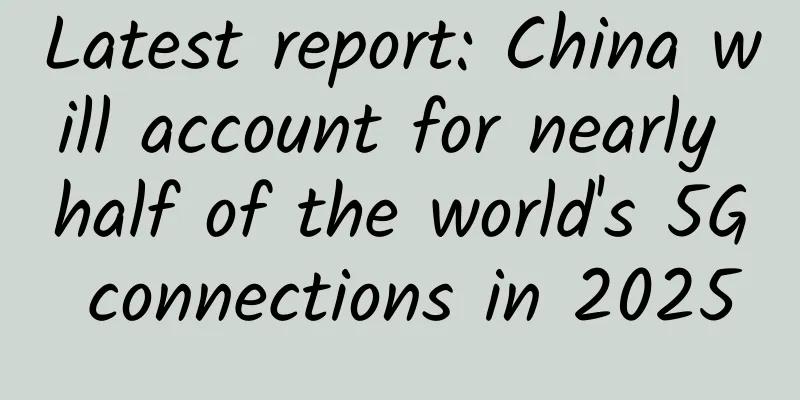Latest report: China will account for nearly half of the world's 5G connections in 2025

|
According to the latest "2021 Global Mobile Economy Report" released by GSMA, by the end of 2025, 5G connections will reach 1.8 billion, accounting for more than one-fifth of the total mobile connections, among which the four most developed markets in North America and Asia-Pacific are expected to have the highest adoption rates. By then, two-fifths of the world's population will live in 5G network coverage.
GSMA said that in 2025, 51% (219 million) of the total mobile connections in North America will use 5G networks, while China will have 858 million 5G connections, accounting for almost half of the world's total 5G connections by 2025. By the end of 2020, there were 5.2 billion unique mobile subscribers worldwide (67% of the population), no significant change from 2019, which the GSMA explained was because the market was becoming saturated. In leading 5G markets such as China, South Korea, and the United States, 4G adoption has peaked and, in some cases, has begun to decline. In many other countries, especially in developing regions, there is still a lot of room for 4G networks to grow. Most of the growth in 4G will come from existing 4G infrastructure, as 5G will account for 80% of total capital expenditures over the next five years. Globally, 4G adoption will peak in 2023 (just under 60%) as 5G adoption begins to climb rapidly in new markets. The report states that the mobile economy and services contributed $4.4 trillion to global GDP in 2020, up from $4.1 trillion generated in 2019. By the end of 2025, the mobile industry is expected to contribute nearly $5 trillion to global GDP. On spectrum, the GSMA called on governments to reassess the environment for mobile services as a way to accelerate investment and innovation, and for "effective" spectrum pricing policies to make 5G services more affordable and provide better quality of service. GSMA also called on governments to increase spectrum availability by opening up 80MHz-100MHz of spectrum bandwidth to each operator in key 5G mid-bands (such as the 3.5GHz band), and 800MHz of spectrum to each operator in the millimeter wave high-band. |
<<: Halfway through 2021, China Broadcasting and Television 5G begins to accelerate
>>: Addressing the risk of permanent roaming through network localization
Recommend
With the advent of 5G, will the future of commercial Wi-Fi be a setback or a step forward?
Entering the Internet age, the Internet allows pe...
In simple terms, what exactly is blockchain?
On September 4, 2017, the Chinese government offi...
Current status of 5G networks in various countries: South Korea ranks first in penetration rate, the United States ranks first in network speed, what about China?
In the rapidly developing 21st century, one of th...
OVH France/Canada High Defense VPS 50% off for the first month, starting from 14 yuan
Oluyun is a new Chinese hosting company that open...
Gigsgigscloud Japan CN2 limited package (TYO-V-SE-01) from $22/month, three-network CN2 return
Gigsgigscloud launched a Japanese data center clo...
80VPS: 330 yuan/year KVM-2GB/40GB/3M/Hong Kong & Japan & South Korea data centers
80VPS is a long-established Chinese hosting compa...
Tongcheng Yilong Wang Xiaobo: Cache should be managed in this way to handle high-concurrency scenarios with ease!
[51CTO.com original article] The Global Software ...
LOCVPS new Japanese SoftBank line VPS, native IP, 20% discount promotion
After the Lunar New Year, LOCVPS launched a new V...
[Black Friday] RAKsmart: VPS flash sale from $0.99/month, cloud server flash sale from $1.99/month, dedicated server flash sale from $30/month
In November, we not only have our Double Eleven S...
The United States has approved 6G trials. Is this a far-sighted move or a desperate attempt?
Recently, US President Trump announced the approv...
You want to ask me about the application layer? I'll just talk to you about it.
Network applications are the reason for the exist...
VMISS newly launched Korean VPS with 30% discount, 1G memory package starts from 3.5 Canadian dollars (≈ RMB 18) per month
In May this year, we shared information about VMI...
How to deliver security as code: 11 tips to get started
Security as code and security by design are hot b...
RackNerd adds new Seattle data center, 1GB memory package costs $11.95 per year
In the middle of last month, we shared the news t...
Byte One: The server is down, is the client's TCP connection still there?
Hello everyone, I am Xiaolin. I received a privat...









